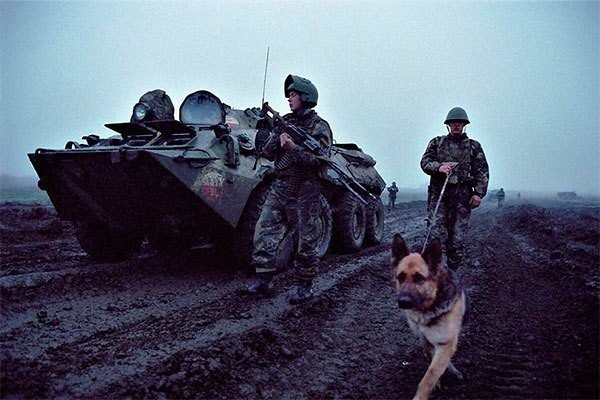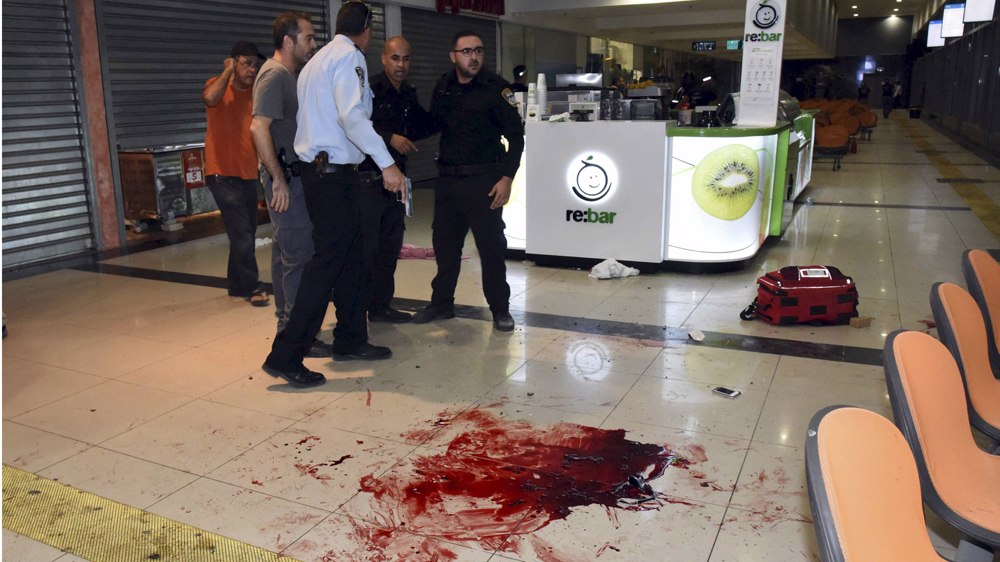In the previous article, we talked about the effectiveness of the impact of medium-caliber artillery on Russian warships in the Battle of Tsushima.. For this we, using battle statistics 27 January and 28 July 1904 city, attempted to calculate the number of hits on the ships of the Russian squadron in Tsushima. Unfortunately, no damage description, which inflicted shells with a caliber of 152-203 mm in cases known to us, the article was not complete.
But first, you need to decide on the criteria for the effectiveness of artillery impact: we say "serious damage", or "decisive damage", "Drop in combat capability", what is it? We will proceed from the fact, which seriously reduces the ship's combat effectiveness:
1. Destruction or incapacitation (difficulty of action) guns with a caliber of 152 mm and more. notoriously, what caliber artillery 75 mm and less did not play any significant role in the naval battles of the Russo-Japanese War, unless we are talking about duels of very small ships, like 350-ton destroyers, but there, it took a lot of hits to get a noticeable effect;
2. Disabling the fire control system;
3. Damage, leading to the ingress of water into the ship and causing severe heel or trim;
4. Damage, reducing the speed of the ship or disabling its steering, or otherwise obstructing control of the ship.
As for the fires, then the fire in itself still does not significantly reduce the ship's combat effectiveness, and we will only take them into account if, if it led to consequences, listed above - that is, disabled the artillery, reduced speed, etc..
The total number of medium caliber artillery shells, caught in the Russian battleships during the battle 27 January 1904 g, relatively small (just four hits, the rest went to the cruisers), which does not give us a representative sample. The battle in the Yellow Sea is different, held 28 July 1904 g. The statistics of hits on Russian ships are good here because, that it can be considered very reliable - as you know, not a single battleship V.K. Vitgefta did not die in battle and was not captured, so our sailors and engineers had enough time to study the damage to their ships upon their return to Port Arthur.
Squadron battleship "Tsesarevich"
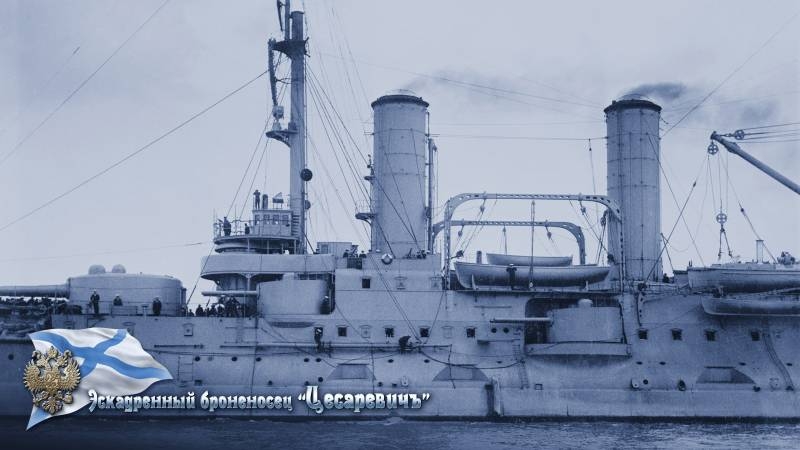
Total "Tsarevich" received 26 hit, of which 14 - heavy shells (11-305-mm, 2-254-305-mm and one - 254 mm) and 12 - medium- and small-caliber artillery (1-203-mm, 6-152-mm, and 5 - unknown caliber, which we decided to count as 152 mm). What damage did they do?
No artillery, no fire control devices received significant damage. One 305-mm and one 254-mm shell hit the bow turret of 305-mm guns.. The tower did not receive noticeable damage and remained in service. The bow and stern 152-mm turrets on the starboard side received one round of an unknown caliber (152-mm?). There was no serious damage, unless in the bow tower from the blow tore the mount of the horizontal laying rheostat.
The fire control system was not disabled.
The battleship received 9 hits in the body with shells of different calibers. The most significant was the impact of a 305-mm projectile in the armor belt in the bow of the battleship (starboard, in front of the main turret). The shell did not pierce the armor, but slid down on it and exploded in front of the unarmored skin. No holes formed, but the seams of the sheathing have parted, resulting in the ship took 153 tons of water, a lurch in 3 degrees, which later had to be corrected by counter-flooding. The rest of the hits did not cause significant damage.
A 305 mm AP shell hit the conning tower, true - not all. He fell undershot, ricocheted off the surface of the water, and then the fuse went off (bottom), so that only the head part flew to the conning tower - but that was enough, to destroy the machine telegraph, Interphone pipe, steering wheel, compass - as a result, the ship temporarily lost control. The hit of a 305-mm projectile in the navigator's cabin destroyed the command staff of the Russian squadron. Another shell of the same caliber, foremast, led to, that she kept "on parole" and could collapse at any moment (one of the most important reasons, that the battleship did not go to Vladivostok).
Three hits of 305-mm shells in the pipes of the ship, although they did not cause problems in battle, but seriously reduced cravings, increasing coal consumption to such an extent, that a breakthrough to Vladivostok without replenishing its reserves became impossible.
In this way, serious damage caused 7 large-caliber shells from 14 hit. At the same time, a dozen medium-caliber hits (2 - in medium-caliber turrets, one to the foremast, the rest - in the hull and superstructures of the battleship) did not cause significant damage to the ship. The only major damage, which may relate to the effect of medium-caliber projectiles – the fire tank was damaged by shrapnel, which led to the leakage of water into the bow of the ship, which caused difficulties in management, since the battleship began to obey the helm worse. But the problem is, that no source indicates a projectile, the fragments of which this damage was caused.
Squadron battleship "Retvizan"
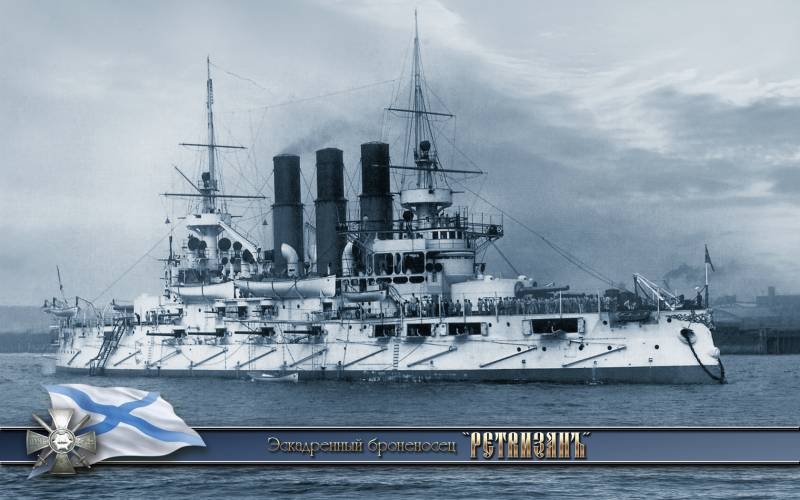
Received 23 hit, including 6 large-caliber shells (5-305-mm, 1-254-305-mm), four - medium caliber (1-203-mm and 3-152-mm), and 13 shells of unknown caliber (hereinafter we refer them to medium caliber artillery).
The hit of a 305-mm projectile in the bow tower caused a fire in it (thanks to the impeccable actions of the calculation, it was immediately extinguished) but the electric aiming drives no longer worked, and the tower itself is jammed. Another shell of the same caliber hit the lower aft casemate of 152-mm guns - the guns were not damaged, but the control devices for her shooting were out of order.
Large-caliber (305-mm, according to other sources - 254-305 mm) the shell hit 51 mm armor plates in the bow, in the area of the infirmary. The armor was not pierced, but lost integrity (cracks) and she was pressed into the body. As a result, water began to flow into the battleship. (which was aggravated by the lack of drainage means in the damaged compartment), the battleship received a trim on the nose.
In this way, of six large-caliber shells, caught in the ship, significant damage caused three. Seventeen medium- and small-caliber projectiles, caught mainly in superstructures (but also into pipes, mast, one 203-mm - in the case) battleship, did not cause any significant damage to the Retvizan.
Squadron battleship "Victory"
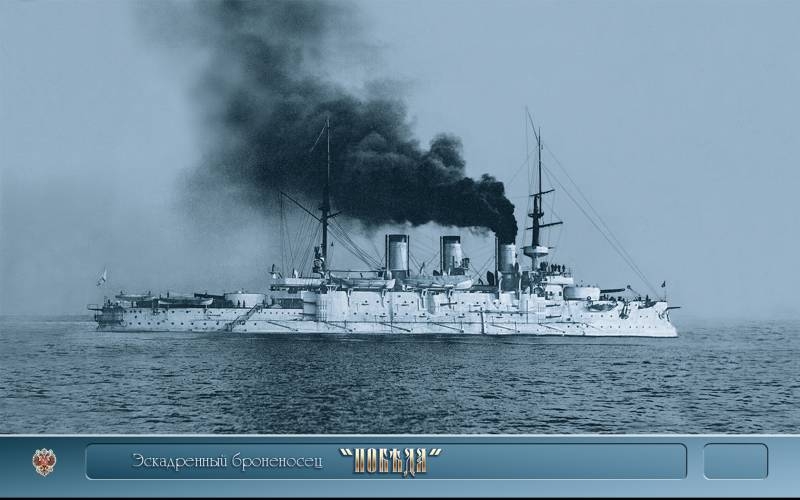
Received 11 hit, including - 4-305 mm, 4-152-mm 3 unknown caliber.
Single hit, to some extent significantly affected the ship's combat effectiveness, happened in the first phase of the battle, when the 305-mm projectile hit 229 mm armor plate under the bow casemates of 152 mm guns. The shell knocked out a cork in the armor about 356 on 406 mm, but in general did not pass inside (only the warhead was found in the ship), nevertheless, as a result of this hit, the lower coal pit and three more compartments were flooded.
Need to say, what another 305 mm shell, hitting the starboard side, destroyed the cabins of the conductors, and the hole was filled with water. However, the constant pumping of water by pumps led to, that the water in the hull "did not linger" and did not entail any consequences for the ship - accordingly, we have no reason to consider this damage serious.
Seven hits are few- and medium-caliber artillery five fell into the corps, one into the chimney, for one more - there is no description. Four 152-mm shells are disabled 3 75-mm guns, but we agreed not to consider such damage significant. From eyewitness statements, one can assume, that there were other hits of shells of various calibers in the side armor of "Victory" (i.e, that more shells hit the ship, than 11), but they did not cause any damage to the ship.
In this way, of the four 305-mm shells hitting the ship, one, few out of seven- and medium caliber - none.
Squadron battleship "Peresvet"
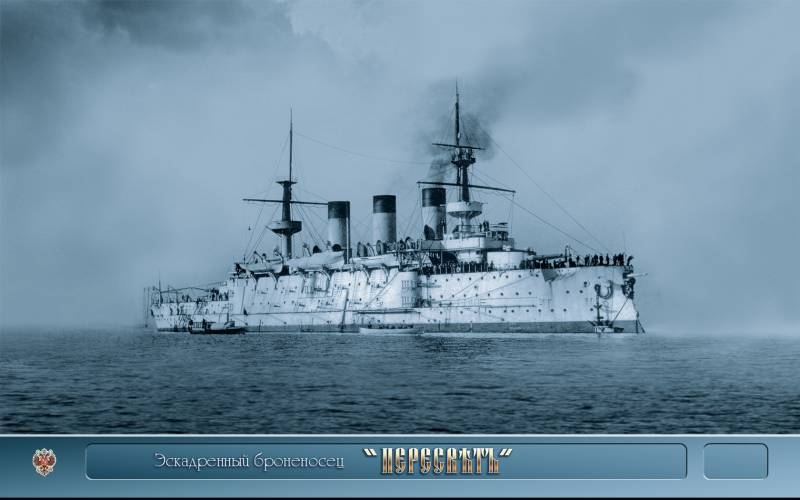
The Japanese have achieved 35 hits on the ship. Hit the battleship 13 large-caliber shells, including 11-305 mm, 1-254-305-mm and 1-254-mm, and 22 smaller projectiles (1-203-mm, 10-152-mm, 1-76-m 10- unknown caliber).
Two shells (305-mm and 254-305-mm) hit the bow turret of the main battery, causing her severe damage and jamming her. The tower retained limited combat effectiveness - the guns retained the ability to occasionally shoot, but the tower itself practically could not rotate. Another 305-mm shell hit 102 mm armor, I didn't break it, but from the shock, the lifting mechanisms of the 152-mm gun in the 3rd casemate were out of order. One 305-mm projectile hit the middle casemate, why the 152 mm gun was jammed (two more 75mm cannons were disabled).
A 305-mm projectile hit the foremast above the navigator's cabin, among others (not too significant) The rangefinder of Barr and Stroud was disabled.
Two 305-mm shells hit the bow of the battleship on both sides of the bow bulkhead. Fortunately, the bulkhead itself miraculously remained intact, and kept the water flow from the closest hit to the stem (so we will not consider it essential). However, the second round led to severe flooding of the living deck., as well as water ingress into the turret compartment, branches of bow mine vehicles and dynamos. Intense damage control rescued the ship from more serious consequences.. Another 305 mm projectile (most likely - armor-piercing), pleased in 229 mm armor plate, chipped off part of it, pressed inward on 6,6 cm, the shirt behind the armor was crumpled and destroyed, the edge of the armor plate – kick back. Through this hole, Peresvet received 160 tons of water, which had to be "straightened" by counterflooding. Besides, at 178 mm section of the armor belt was hit by two shells of an unknown (152-254-mm) caliber, armor was not pierced, but led to damage to the shirt and the casing behind the stove - however, this did not cause significant flooding, so we ignore hit data.
The battleship was hit 2 305-mm projectile and three projectiles 120-152 mm. In general, the pipes of "Peresvet" were seriously damaged, causing increased coal consumption, and the reason for this was damage, inflicted by 305-mm shells from the second and third pipes of the ship. However, modern researchers (AT. Polomoshnov) speculate, that it was all the same hits with 203 mm shells, since the nature of the damage (severely damaged outer casing with much less damaged inner) characteristic specifically for 203-mm shells. Such damage was inflicted by the 203-mm shells of the armored cruisers Kamimura to the pipes of the cruisers of the Vladivostok detachment, but for the pipes of the "Tsarevich" the opposite was typical - high-explosive 305-mm shells made huge, holes approximately equal in area as in the outer, and in the inner casing.
With all the weight of this argument, we still cannot accept it - all the same, Russian sailors, who had the opportunity after the battle to familiarize themselves in detail with the nature of the damage, came to the conclusion, what is it exactly 305-mm caliber. Besides, the author of this article can give a logical explanation for such an incident. The thing is, that the Japanese massively changed British fuses in their shells of large-caliber cannons for "instant" fuses of their own design (Yijuying), ensuring the detonation of the projectile at the moment of contact with the armor, without any slowdown. This innovation also affected armor-piercing shells. (probably, not all, but still). That is, in theory, the pipes of "Peresvet" could get 305-mm armor-piercing shells with a low content of explosives (that, by the way, not so much different in mass of explosives from high-explosive 203-mm shells), but with "instant" fuses, which caused the known similarity of damage.
Medium caliber artillery, yet again, success is not achieved. One shell of unknown caliber hit the aft turret, and one more - to the casemate, but it didn't hurt the artillery. The bulk of the shells hit the hull (12 hit), but the only noticeable damage to the battleship was the massive breakdown of unarmored 75-mm guns - and only. Three more medium-caliber shells hit the pipes (without causing serious damage), two into masts and three (unknown caliber) - in the bridges.
In this way, of 13 large-caliber shells caused significant damage to the ship 7, and from 22 few- and medium-caliber shells, not a single.
I would especially like to note, that we are only considering hits during the daytime battle with squadron X. Togo, therefore, damage to one 254-mm gun of "Peresvet" by a direct hit from a 57-mm shell from a Japanese destroyer during a night attack is not taken into account - and, anyway, it would refer to the effectiveness of small-bore, not medium caliber artillery.
Squadron battleship "Sevastopol"
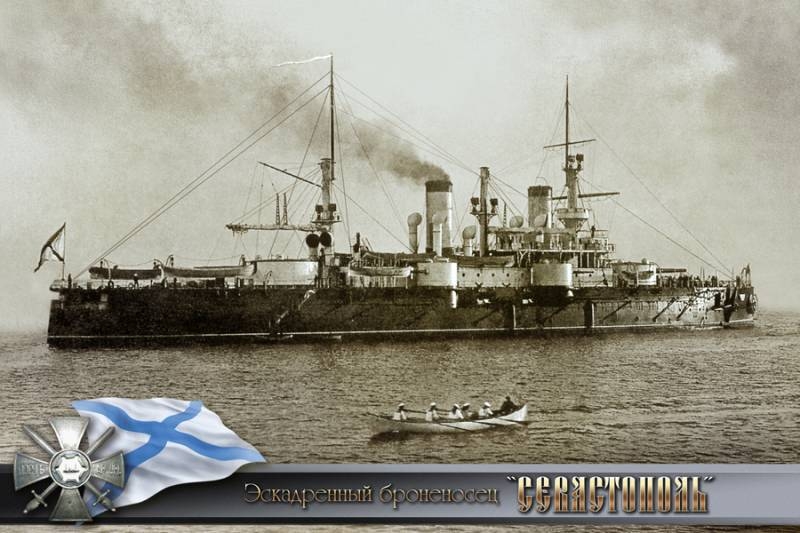
Twenty one hits, including 10 – 305 mm, one - 152 mm and 10 - unknown caliber.
One 305-mm shell hit 127 mm armor belt and did not pierce it, but from the shock, the electrical equipment of the right aft tower was out of order, as a result of which ammunition had to be fed into it manually. An unknown caliber shell knocked the rangefinder off the bridge.
One 305 mm projectile, hitting 368 mm armor belt, pushed the slab inward, why two corridors were flooded and a leak opened in the place, previously damaged by the "Peresvet" ram. Another high-explosive projectile of unknown caliber, hitting the stern tube casing, broke the steam pipes in the aft stoker, why for some time the speed of the battleship dropped to 8 knots.
This way, of 10 305-mm shells caused serious damage to the ship 2, and further 2 of 11 other hits. Rest 7 shells of unknown caliber hit the ship's hull, one in the mast and one 152 mm shell was found unexploded in the boat, they did not cause much damage to the ship's combat capability.
Squadron battleship "Poltava"
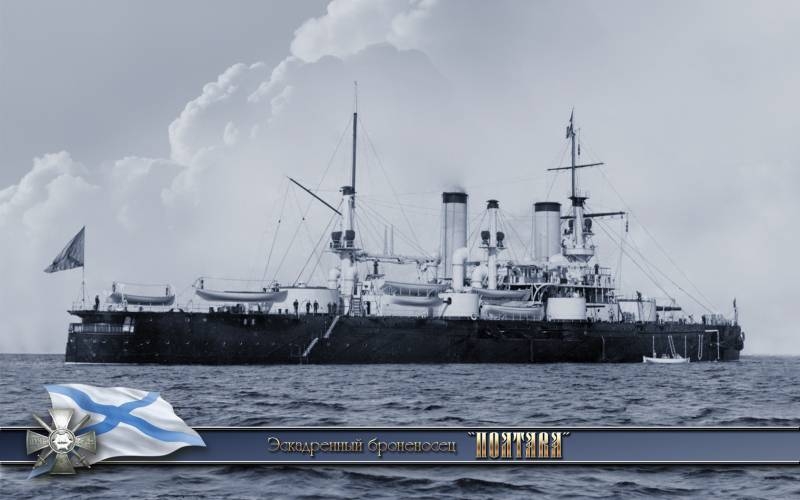
The ship was 24 hit, including 16 large-caliber shells (15-305-mm and 1-254-mm), as well as a 4-152 mm projectile and 8 shells of unknown caliber.
Two 305-mm shells hit the unarmored side under the right nose turret of 152-mm guns and jammed it. The rangefinder was damaged by shrapnel, but, Unfortunately, not specified, which shell fragments caused this damage, but judging by the description of hits, it can be claimed as 305 mm, and medium-caliber shells.
A shell with a caliber of 305 mm hit the stern, into the unarmored board below the waterline. Dry food premises flooded, water also flowed into the steering compartment. The last was drained by the labor of the crew, but still had to use counterflooding, by taking water into one of the bow compartments. Two 305-mm shells hit the unarmored side just above the waterline, almost to the same place (aft lower officers' section), as a result of which a huge hole of about 6,5 on 2 m, and it began to overflow with water. The battleship received a trim on the stern.
A shell fragment hit through the light hatch of the engine room directly into the bearing of the left side vehicle., which led to a drop in the speed of the battleship. However unknown, where did this shard come from - the sources do not contain descriptions of the corresponding shell hit. In other words, completely unknown, where could this splinter come from - it could be like a large-caliber, and from medium-caliber shells.
In this way, of 16 large-caliber shells, serious damage caused 5, Besides, perhaps one of them disabled the rangefinder. Twelve hits average- and small-caliber shells led nowhere, although maybe the rangefinder still brought out the fragments of one of them. In addition, one fragment of a shell not accounted for in these calculations damaged the bearing in the car..
Summarizing, we can state the following. Of 63 large-caliber shells, caught in the battleships of the 1st Pacific squadron, substantial, significant damage caused 25 shells. Of 81 hitting them with the same projectile of caliber 203 and below, similar damage inflicted only 2. Besides, there are two serious injuries (shrapnel breaking through a fire tank on the "Tsarevich" and failure of the rangefinder on "Poltava"), caused by shell fragments, the caliber of which we do not know. And there is still nowhere that splinter came from, damaged the car "Poltava".
In this way, true performance of large-caliber and medium-caliber Japanese shells in daytime combat 28 June 1904 city, whichever, where to distribute controversial and unknown damage, is in between:
1. Of 64 large-caliber shells inflicted significant damage 28 of 81 finely- and medium caliber - 2;
2. Of 63 large-caliber projectile caused significant damage 25 of 82 finely- and medium caliber - 5.
In this way, we see, that even with the most favorable assumptions in favor of medium-caliber artillery, its effect on large warships in the battle in the Yellow Sea is extremely insignificant - from 30 hit, causing serious damage, medium caliber accounts for only 5 or less 17%. The probability of causing serious damage by hitting a 254-305-mm projectile was 39,7-43,8%, and with a medium-caliber projectile, only - 2,5-6,1%.
“But what about the fires? After all, there was no mention of them " – dear reader asks. Unfortunately, we have nothing to answer him, because there is no description of at least one fire, which would have serious consequences for a squadron battleship. You don't need to think, that the battleships of the 1st Pacific Squadron did not burn - for example, on the battleship "Sevastopol" the presence of 7 fires during the battle. Nevertheless, none of them made any significant drop in combat effectiveness.
Let's move on to the battleship Eagle.
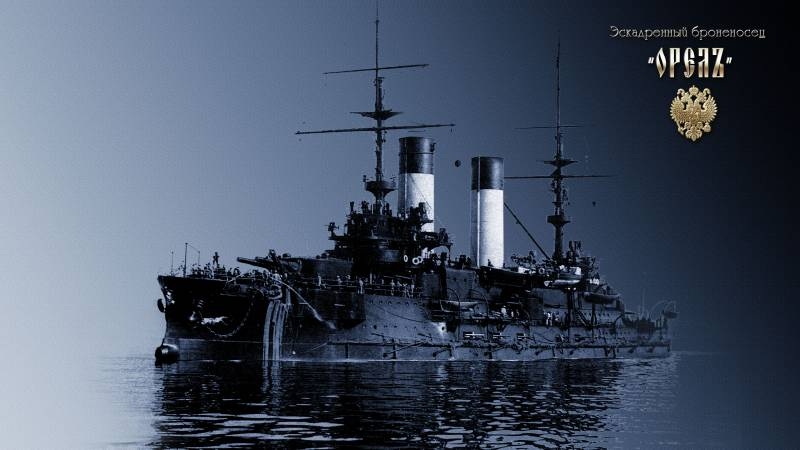
The most, perhaps, difficult - determining the number of hits on the ship. Sources, in which they are given, quite a bit of, but the reliability of any of them inspires certain doubts.
Let's start with Vladimir Polievktovich Kostenko, who reported 42-305mm and 100 152-203-mm hits, not counting splinters and small-caliber artillery shells. figures, obviously, very much overestimated. Official Japanese historiography reports 12-305 mm shells hit, 7-203-mm and 20-152-mm, but it obviously follows from the text, that only part of the hits are indicated, and not their total number. The data of H. J.. Campbell, which the, based on information from the British and German attaches, as well as in the many photographs available to him, has concluded, that the "Eagle" got 5-305-mm, 2-254-mm, 9-203-mm, 39-152-mm shells. But still, his data is incomplete - in his work he could not rely on Russian sources, and this is also very valuable information.
According to the author of this article, excellent analytical work was done by A. Danilov in his article "Damage to the battleship" Eagle "in the Battle of Tsushima". He brought together the data of known sources and came to the conclusion, what got into the Russian battleship 11 shells with a caliber of 254-305 mm, 3 203-305-mm, 10-203-m, 7 152-203-mm, 20-152-m 12 - 76-152 mm. However, one should understand, that this is not at all the final result and later other data may be obtained. At the same time, one cannot fail to note the peculiarities of Japanese historiography., managed to make a fog even in such, relatively simple question.
Well, now let's consider the most interesting thing - damage to the battleship "Eagle". We will analyze them based on the descriptions of an eyewitness to the Battle of Tsushima, Captain 2nd Rank K.L.. Sweden (Report to the Main Naval Headquarters of the senior officer of the battleship "Eagle", from 1 February 1906 , the number 195), comparing them with the data H. J.. Campbell “The battle of Tsu-Shima”. Let's start with artillery.
Bow 305mm turret - serious damage, caused by a projectile 203-305 mm.
From the report of K.L.. Sweden: 12 inch. shell, caught in the muzzle of the left bow 12 inch. guns, beat off a piece of barrel foot on 8 from the muzzle and threw it onto the upper nasal bridge, where they killed three people below. ranks and jammed him upright there ... ... 12 inch. shell in the barrel of the left 12 inch. bow gun, - right 12 inches. the bow gun remained intact, only the charger of the right gun is out of order. They began to supply charges to the surviving left charger. and the shells are hoists ".
According to N. J.. Campbell, the projectile was 203 mm, and not 305-mm.
Aft 305mm Tower - Serious Damage, caused by a projectile of 203 mm or more.
From the report of K.L.. Sweden: "Large caliber shell, caught in the stern of the armor above the embrasure of the left 12 inches. stern gun, distorted the frame of the embrasure and, pushing the armor over the gun, limited the elevation angle of the gun, so that this weapon could only act on 30 cable ".
According to N. J.. Campbell: "Part of the roof aft 12″ turret above the left gun port was pushed inward by hitting 8″ shell, limiting the angle of elevation of the gun ".
Left 152mm bow turret – disabled by a 203-305 mm projectile.
From the report of K.L.. Sweden: "In the left nasal 6 inch. the tower was 3 hit 6 inches. shells; the tower continued to function properly ", but then: "6 inches. the left bow tower was completely destroyed, the frame of the left gun burst in it. The toothed shoulder strap was dented at the bottom and the gear was broken; in the projectile feed compartment, the turret rollers were pressed on one side, a connected ring burst on the left side, and from the same side, the plate of the armor of the vertical table moved away. Almost all of the bolts have been stripped from the thread. The upper part of the plates was supported by two bolts, the roof of the tower was raised over the embrasures, caps ripped off bolts. Major destruction has been done 12 inch. shell, caught in the lower part of the armored rotating part of the tower. Everything was in the tower 4 or 5 hit. 12 inch. shell, destroyed 6 inch. bow left turret, destroyed the medical assistant's cabin in the upper deck and pierced the upper armored deck with a thickness of 1 1/16 inch."
According to N. J.. Campbell, shell, hit which disabled the tower, was 203 mm, and not 305-mm.
Left middle 152mm turret - serious damage, caused by a 203-305 mm shell.
From the report of K.L.. Sweden: "In the middle 6 inch. left tower two hit 6 inch. shell; first hit the vertical armor, but did not pierce it, ripped apart without harm to the tower; the second one exploded on the roof of the tower. Shards, flown in through the neck for ejection of cartridges and through the gunnery cap, severely wounded the tower sergeant and 2 below. chips, - one fatal. Shrapnel broke the mechanism for opening the tower door from the inside.. shell 8 inch. or large caliber, caught in vertical table armor, ricocheted into light board, at the break tore it apart, than limited the angle of shelling of the tower in the stern from the traverse. "
n. J.. Campbell does not describe this damage (This does not mean, that he was not, just this author has described only a few, the most important damage that seemed to him).
Left aft 152 mm turret - serious damage, caused by a projectile of unknown caliber, Most likely, 203-305-mm.
From the report of K.L.. Sweden: "Guidance is correct, one gun is jammed by a segment projectile due to a fragment, caught in the barrel. Another weapon is covered with shrapnel, which made them afraid to shoot from it. "
n. J.. Campbell does not describe this damage.
Basically, the projectile could be of any caliber, but there is a nuance - K.L. The Swede talks about the segment projectile, and this is most likely 305 mm. At the same time, a 203-mm projectile exploded near the left aft turret - possibly, it was his fragments that damaged the guns.
The right nose 152-mm turret could only operate manually, the wires and windings of the motors are burnt out. Serious damage, caused by shell fragments of unknown caliber.
From the report of K.L.. Sweden: "at that time, at the start of the fire to starboard, there was a fire in the right bow 6 inch. tower, commanded by Leith. Geers. The fire was caused by the ignition of cartridges in the fenders, which were ignited by a red-hot shard, who flew into the tower through the opening in the roof for throwing out casings. All the servants of the tower are out of order. ".
According to N. J.. Campbell, damage caused by shrapnel, the caliber of the projectile is not specified.
Right Medium 152mm Turret - Serious Damage, caused by a projectile caliber - 203-305 mm.
From the report of K.L.. Sweden: "It fixed manual vertical guidance, t. to. the wires and windings of the motors are burnt out, bucket elevators were fixed and cleaned, torn chains connected. The tower could not rotate, t. to. a large-caliber projectile jammed it along the traverse and did not have time to chop off the Mamerino ".
According to N. J.. Campbell, the projectile was 203 mm.
Right aft 152 mm turret - guns are operational, but the tower itself is jammed. Serious damage, caused by a 305 mm projectile.
From the report of K.L.. Sweden: "In the mamer and in the vertical armor of the right stern 6". tower, horrible two 6 inch. shell. With the second shell, the tower was wedged outside into the mamer, but the tower commander is Warrant Officer Bubnov with a tower servant, coming out of it, cleaned mamerinets, which was jammed by a stuck shell fragment ".
At the same time K.L. Swede does not give a description of the hit, completely jammed the tower, only confirms the fact of its failure.
According to N. J.. Campbell, the projectile was 305 mm.
Fire control system - disabled, serious damage, caused by a 203 mm projectile.
From the report of K.L.. Sweden: “There were three hits in the conning tower 6 inch. shells below the slot, without causing harm. Shrapnel fell continuously from the shells bursting nearby. Many debris flew into the slot, especially small, showered standing in the wheelhouse. 8-mi inch projectile, ricocheting off the water, at the end, hit from the left side into the slot of the conning tower. The explosion of a shell and its fragments smashed the rangefinder of Barr and Stroud, spoiled battle markers and crumpled many communication pipes, damaged the compass and steering wheel ".
n. J.. Campbell does not describe this damage.
For other damage, received by the battleship "Eagle", as a serious one, one hit of a 305-mm projectile in the lower armor belt of the left side in the area of the aft 305-mm turret can be distinguished. The armor plate 145 mm thick was not pierced, but it shifted and water began to flow into the ship's hull. Shortly after this hit, the ship began to roll. 6 city., which had to be corrected by counter-flooding. There were other hits, displacing armor plates or making a hole not too high from the waterline, but there is no information about, whatever led to serious flooding and heel, or trim, therefore they are not counted as serious damage.
On the "Eagle" was recorded 30 fires, two of them – in medium-caliber turrets we accounted for serious damage. Rest: two - in a battery of 75 mm guns, one at the bow and one at the stern, the rest - in superstructures and on deck, a significant decrease in combat effectiveness still did not cause.
In general, we see, that the statistics on "Eagle" are very confusing. We counted all 10 damage, significantly affected the combat capability of the battleship. But the caliber of the shells that caused them was more or less reliably determined only in three cases out of ten - two 305-mm (damage to the hull and right stern 152-mm turret) and one 203 mm (disabled OMS). Of the rest 7 damage 6 were caused by shells 203-305 mm, and one (fire in the right bow tower) - projectile, generally, any caliber.
According to the author of this article, based on such vague data, it is impossible to draw any reliable conclusions. And all the more, it makes no sense to analyze the hits in the dead ships of the 2nd Pacific Squadron - we know even less about them, than about "Eagle".
At the same time, some conclusions can still be drawn. Noteworthy, that in the battle in the Yellow Sea, absolutely all significant damage, which caused, or could inflict medium caliber artillery shells, concern exclusively non-armored parts. On the battleship "Sevastopol" the rangefinder was damaged and one splinter hit the car through the pipe. Another disabled rangefinder, shrapnel hitting the vehicle through the skylight on the battleship "Poltava") and shrapnel damage to the fresh water tank on the "Revizan", perhaps, are the result of hits from medium-caliber shells (but probably, as large-caliber). At the same time on "Eagle" only in one case (splinters, caused a fire in the right forward 152-mm turret) to cause serious damage (at least theoretically) a 152mm projectile can claim - all other damage was caused by at least 203mm artillery. Also noteworthy are the numerous hits of 152 shells in the armored units of the "Eagle" (three direct hits into the left forward 152-mm turret and conning tower), not causing any damage at all, and the same was observed on the ships of the 1st Pacific Squadron.
In accordance with the above, we can state, that in battles of squadron battleships during the Russo-Japanese War, guns with a caliber of 152 mm or less were practically useless, and 203-mm guns, perhaps, had limited usefulness. But the final verdict in relation to them can be made only after the appearance of reliable descriptions of the damage to the battleship "Eagle".







